type
status
date
slug
summary
tags
category
icon
password
As a remote-first company, our team was all-in on working asynchronously. We value autonomy and flexibility, so maximizing freedom in our calendars felt like the right move. Over time we came to realize that our fierce autonomy was actually creating disconnection and ineffectiveness in our work.
Now, at a time when most folks are advocating for less (or no) meetings, we’ve actually significantly increased the meetings we have and we’re making them effective with the help of Notion.
Let’s take a look at our async-first strategy
For the duration of 2022, our team had one 30 minute sync per week. We would provide a brief “weather check” to update one another on how we were doing, then scan the nice words folks had shared about our course, quickly look at weekly metrics we were tracking, review the check-in forms students had submitted, and discuss any tensions (things that were blocking us).
This was the only time in a week that we would all sync up. Occasionally it ended up being 45-60 minutes, depending on the backlog of tensions to discuss.
Our original weekly Team Sync meeting template.
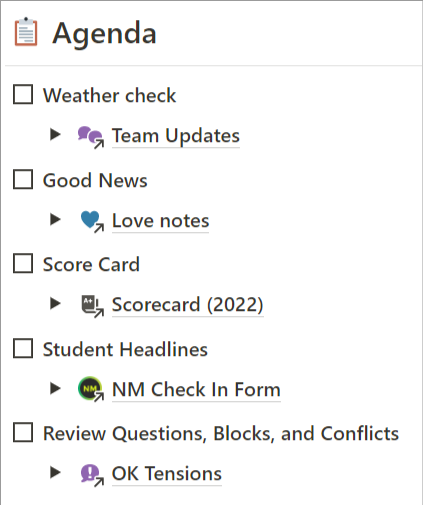
Once per month, we would have a 60 minute “Strategic” sync where we briefly reviewed our vision and roadmap (truthfully we often skipped over this), and then discussed “strategic” tensions (usually things related to products/trainings we were considering offering).
Our original monthly Strategic Sync meeting template.
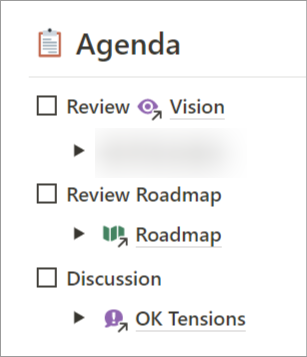
In addition to the above, we would occasionally have ad-hoc meetings to plan out workshops or content.
The rest of the time we were engaging in Notion and through Slack, but predominantly working independently on our projects with little cross-collaboration. It seemed like it should be great—everyone working on what they were excited about, with the freedom to design their everyday, and no scheduling expectations—but it turned out we ended up craving more sync time, not less.
We ended up so siloed in our own work that we were not effectively leveraging each other’s skills and knowledge. Our projects weren’t progressing effectively because we weren’t collaborating creatively, reviewing each other’s work, or holding one another accountable. We were left feeling disconnected from one another since almost all of the interaction we did have was focused on the work. We were missing opportunities to connect as human beings. We were a group of awesome individuals, but as a team we weren’t functioning at our best.
Introducing a more synced up 2023
Realizing the above and where our working style was not truly working for us, we introduced new meeting types and a new meeting cadence which we defined in our Operations documentation:
An overview of our meeting types and cadence.
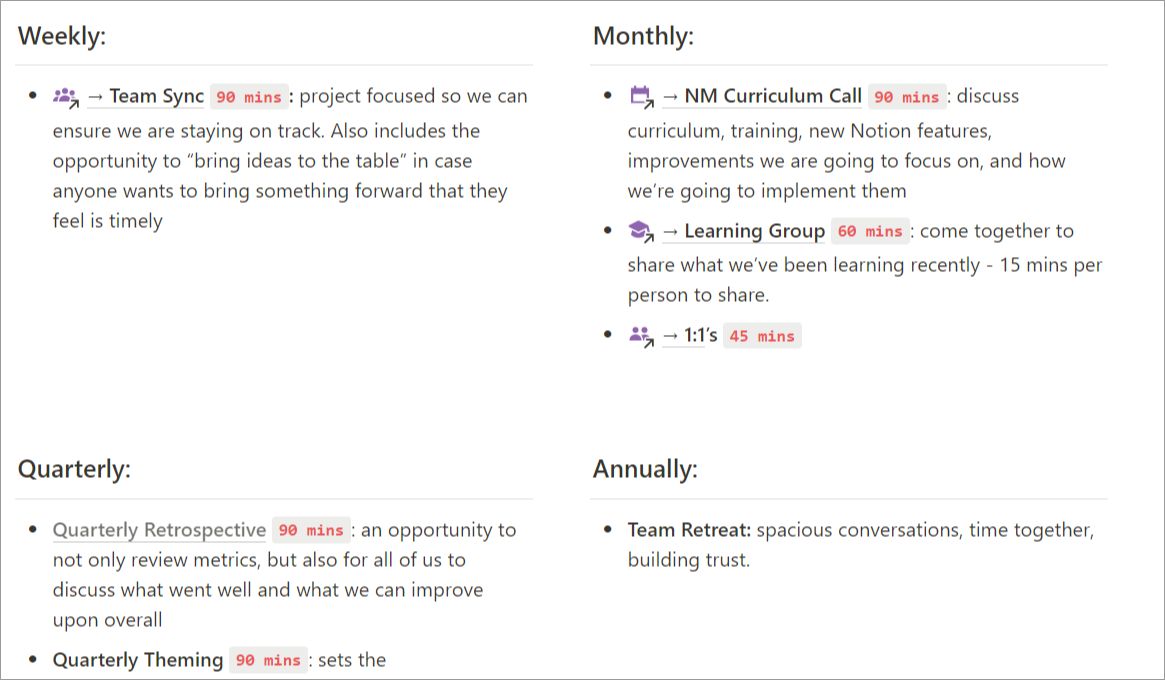
We developed templates in Notion for each of these call types so they each have a dedicated Agenda that helps make our sync time as effective as possible. These templates are stored in our Actions database and we use a single-select
Type property with the value “event” to differentiate our meetings from tasks. Most events benefit from the same properties as our tasks, so it made sense to include them within the same Actions database.The green icons are task templates, the purple icons are meeting templates, in our Actions database.
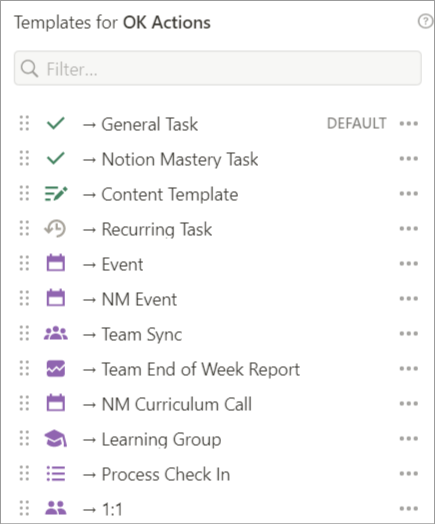
Folks often ask us “how we take notes in meetings”. While we occasionally jot down some bullet points within the body of the database entry, for the most part we add items directly to the various linked databases included in our templates:
- Anything actionable is added to a linked view of the Actions database and assigned to the person responsible
- New product or content ideas are added to a linked view of the Notes + Ideas database
- Workshops we are planning are added to a linked view of the Training database
And so on. Most often these items are added directly to the respective databases, but occasionally we will capture them as bullet points which we drag into the databases after the call (or use AI or Notion’s new Buttons to quickly capture).
We don’t worry so much about capturing everything that was discussed in a meeting, but rather focus on using Notion to operationalize our meetings, capturing the next actions and ideas that will be relevant outside of the context of the meeting so we can execute them or refer to them later.
Facilitation and Documentation
Before I break down the various templates we use for our weekly, monthly, and quarterly calls I wanted to mention how we’re using Notion to share meeting Facilitation and Secretary duties.
All of our meeting templates have
Facilitator:
and
Secretary:
at the top of the page where we can enter the name of the person responsible for each role on that particular call. We have started rotating the roles of Facilitator and Secretary so that we each get an opportunity to “run the meeting” and hone our skills in that regard (except Marie who gets a lifetime pass as Secretary because it’s a job that makes her soul sad

). Sometimes we veer off from the call’s agenda, but it provides a framework that supports the Facilitator to bring us back on focus.
Now then, let’s dive into the templates…
Weekly Calls
Team Syncs: 90-mins
These are our most structured meetings. The agenda template includes many linked databases that we review and utilize together. We used to go over time, most of the time, so having a 90 minute block set aside has been more realistic for us. If we do get to the end of the agenda early, we wrap up the call and have some bonus time for other activities.
Purpose:
- Catch up on how we’re doing and what’s happening in our lives, outside of work.
- Review project updates and progress and ensure we’re staying on track.
- Address tensions to unblock one another.
Structure:
1. Team Update + Verbal Check-In: Our team updates database helps us identify our intentions for the week as well as where we might be blocked or need support. The verbal check-in is one of my favorite parts of our sync because it’s time when we get to share what’s going on in our lives outside of work. I appreciate hearing about everyone’s hobbies, highlights, and even the challenges they’re facing because it helps us all relate to one another on a human level, and not just as proficient task completing machines.
We share an update at the start of each week and start our team sync’s with a verbal check-in.
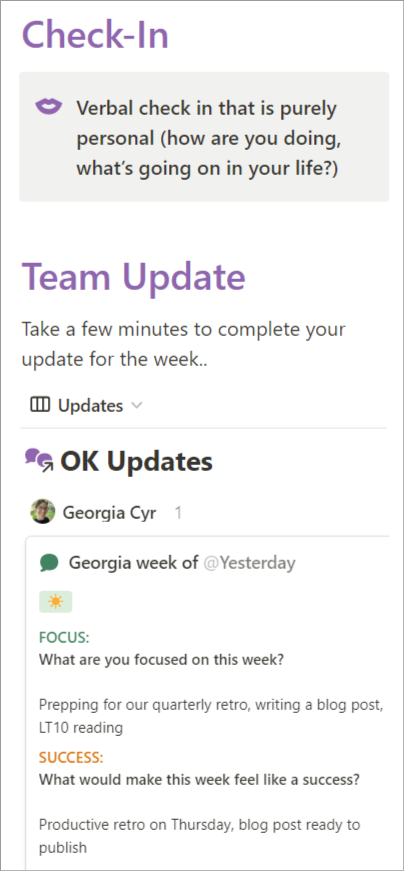
2. Projects + Priorities: During our project updates each team member gives a succinct verbal update about how their projects are doing. There is a list of questions to walk us through what we should share. When we’re using this to its fullest potential it helps us identify where someone is blocked, where we can support, the next step to moving the project forward, and where we might be getting sidetracked.
Our weekly project review process.
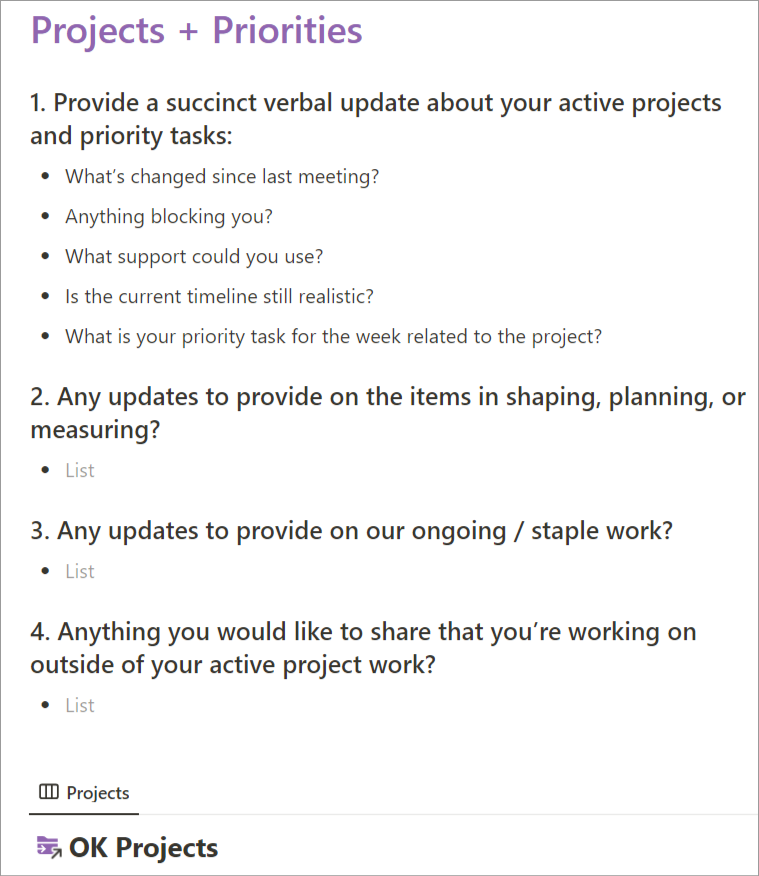
3. Staples: Our staples are the recurring activities we are responsible for delivering in our course and community. Previously these were not explicitly laid out in our projects or tasks. In an effort to make our actual work as visible as possible we now do a quick review of our Staples to make sure we are on track for delivering what we intended or promised.
We review our Staples in an effort to make our work more visible.
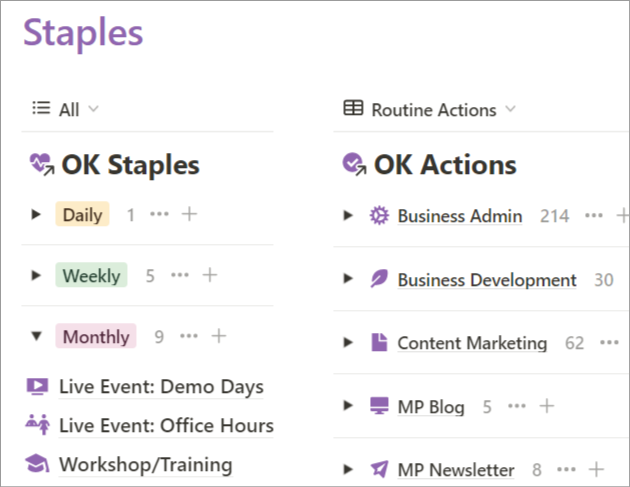
4. Ideas: I’ve shared a bit in another post about how we revamped our project management process, including how we handle ideas. During our weekly syncs we have an opportunity to share any new ideas that we want to bounce off one another or that we want the team to consider activating as a project because we think they are timely.
A linked view of our Notes + Ideas database so we can capture and discuss new ideas.
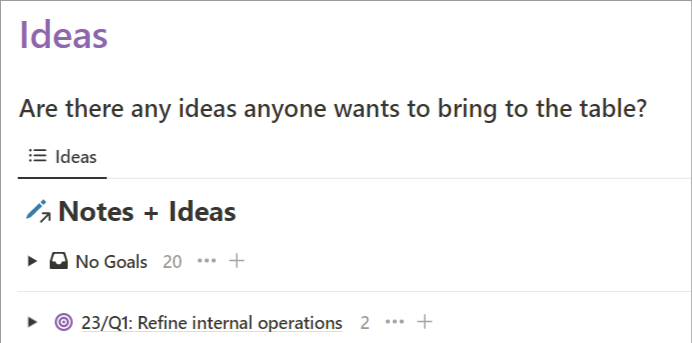
5. Tensions: I’ve written about our Tensions database in another post. During our weekly sync we have an opportunity to process any unresolved tensions in real time.
These are items that are blocking us that we need team input on, or things we want the team to know.
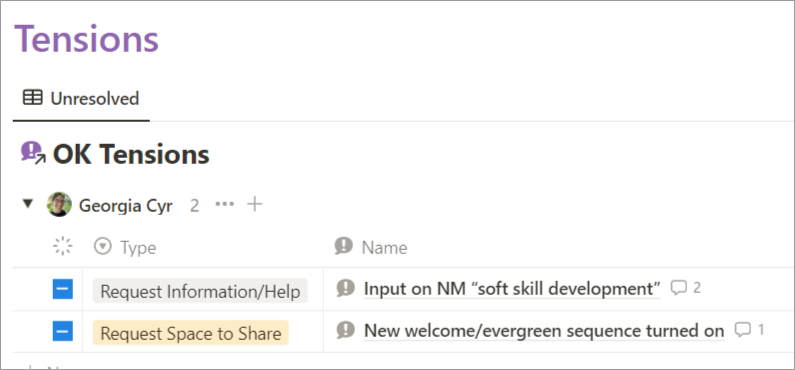
6. Events + Content: We review linked views of our Training and Content databases together to see what’s upcoming and discuss scheduling.
We review upcoming events and content pieces that are in progress.
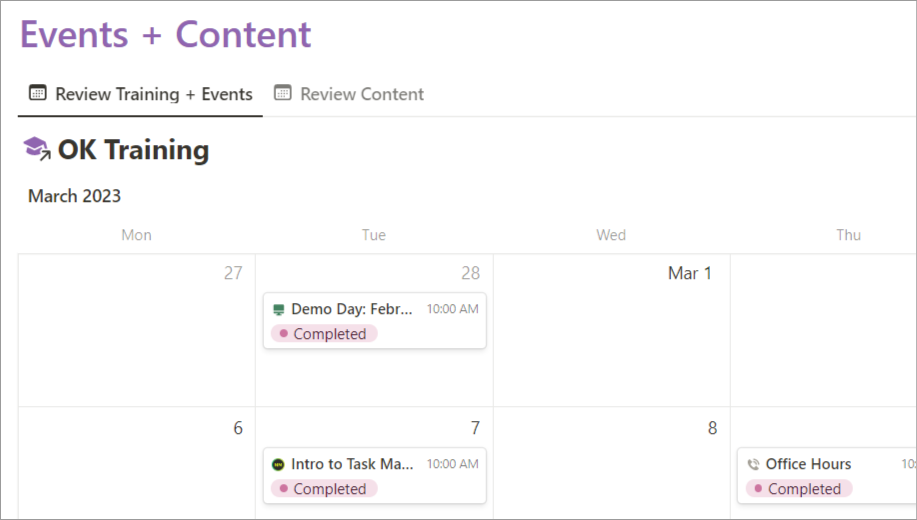
7. Love Notes: A warm fuzzy moment on our call where we get to read the nice things folks have said about our course and community lately.
Reviewing our loves notes is a small opportunity to celebrate what we’re doing well.

8. Check-Out: We have implemented a check-out at the end of all our team calls and it has been such a simple yet effective way to work better together. We do a round-table and each person has the opportunity answer:
- How do you feel about how the meeting went?
- Is there anything else you need in order to feel complete?
- What rest, play, or learning are you excited about this week?
Often the first two questions will help us tie up loose ends or get on the same page. I’ve also witnessed it as a route to quickly resolving conflict between team members. The rest, play and learning reflection is a fun note to end our meetings on and is another way that we connect on a more personal level and get to know each other better.
Ending our calls this way has been a game-changer.

Monthly calls
Notion Mastery Curriculum Call: 90-mins
Purpose: discuss curriculum, training, new Notion features, improvements we are going to focus on, and how we’re going to implement them.
Structure: this template includes a ton of linked databases, combined with discussion prompts.
1. Student feedback: We start with a review of a number of linked databases that contain submissions from our various feedback forms (which we host in Tally). Most of these forms will have been reviewed by our team asynchronously already, but this gives us an opportunity to discuss any themes we’re seeing or talk through anything new we want to implement based on the feedback we’re receiving. I share more about the ways we collect feedback in Notion Mastery here.
We review and identify themes from our intake forms, check-in forms, and feedback forms.

2. Curriculum: We review our Curriculum database and discuss opportunities for updates or improvements.
While we review the curriculum database we are often also updating our Notes + Ideas database based on the discussions that occur.
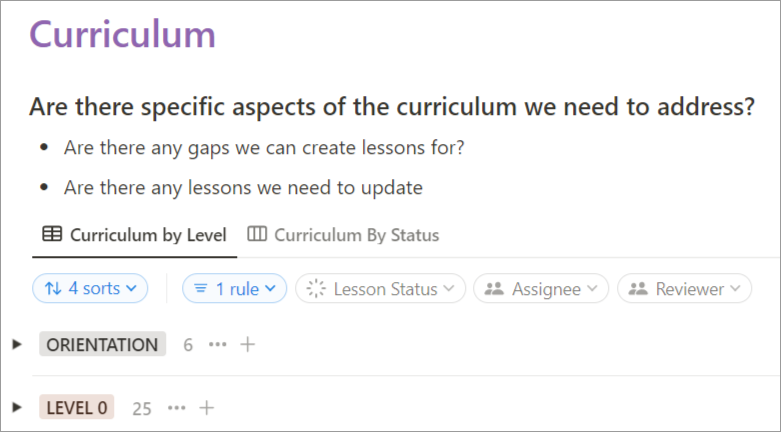
3. Events: We review the events we’ve been hosting, and the reception of those events, and use that information to inform what workshops we want to offer in the future.
This is another instance where our Notes + Ideas database is often in use as we review the past events and what was successful (or not).
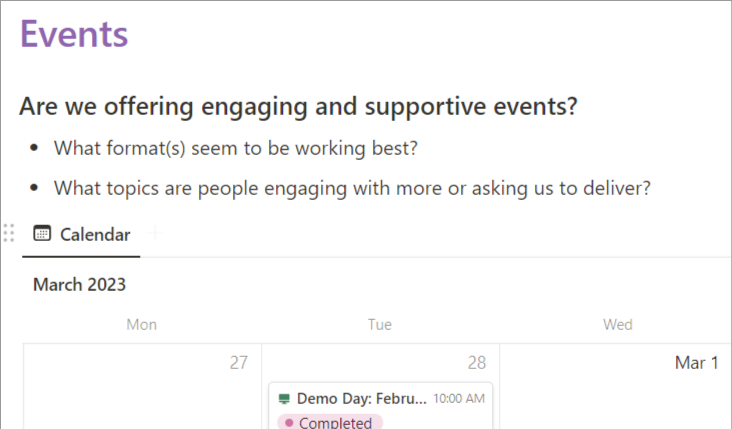
4. Community: We look at metrics from our community which we host on Circle and brainstorm how we can enhance students’ experience there.
We collect analytics from Circle on a monthly basis.
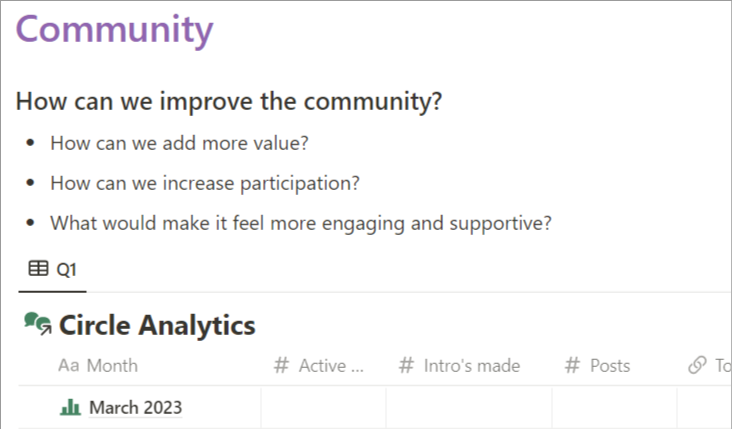
5. Ideas: This is an opportunity to document or discuss any further ideas related to Notion Mastery that we want to consider pursuing.
This Notes + Ideas database tends to get a lot of use during our Notion Mastery calls.
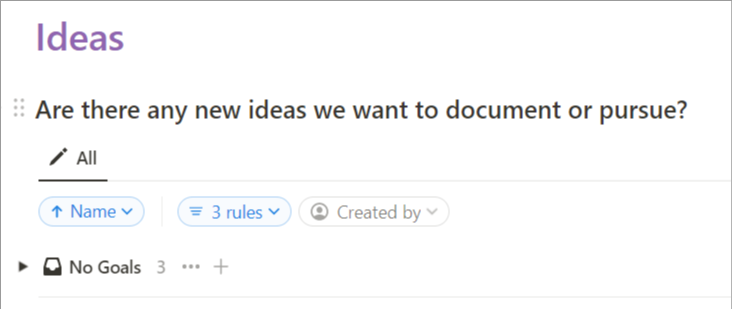
Learning Group: 60-mins
Purpose: come together to have a casual conversation about what we’ve been learning recently.
Structure: this is an opportunity for us to share what we’re learning or are excited about. It’s one of our most casual calls. We each get up to 15 minutes to share:
- What have you been learning about?
- What is exciting you about this topic?
- What has challenged you while learning about this?
- How are you practicing or applying this learning?
The guidelines for our Learning Group calls.
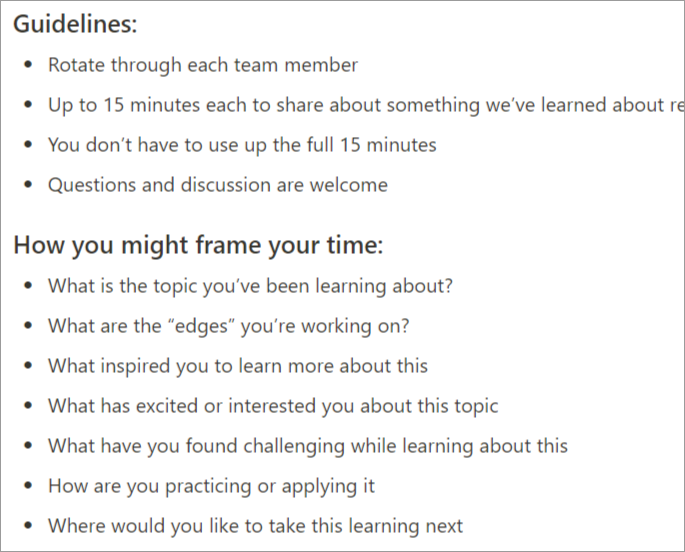
1-1’s: 45-mins
Purpose: have candid conversations about how we’re doing, what’s been going well, what we’ve learned, and opportunities for growth and improvement.
Structure: the agenda for our 1:1’s has taken inspiration from various reflection and discussion prompts including:
- Discussing any Core Needs that are not being met (highly recommend Resilient Management by Lara Hogan if you want to learn more about this)
- Considering how we’re experiencing challenge, low ego, space to reflect and brainstorm, and clear and timely feedback—the 4 elements required for human learning and growth (another tidbit from Lara Hogan who borrowed it from the Learning and Development team at Etsy, originally created and led by Paloma Medina)
- Reflecting on some of the characteristics of a deliberately developmental organization and how we are upholding them (inspired by this article by Maurice Lefebrvre)
Aside from the opportunity to go deeper on how we’re feeling about our work and work environment, and opportunities for learning and growth, these calls are also a nice chance to spend 1:1 together, as we are most often operating in larger groups.
Some of the questions we reflect on and discuss during our 1:1’s.
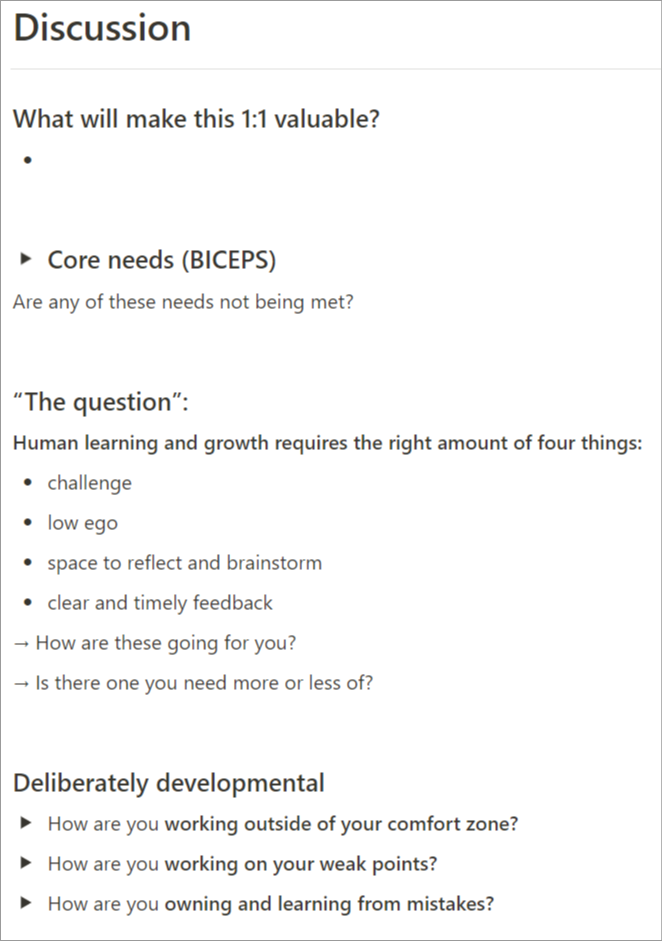
Quarterly calls
Process Check-In’s: 60-mins
Purpose: discuss what is and isn’t working about our systems and how we are working together.
Structure: this template uses a mixture of linked databases, [[-mentioned pages, and discussion prompts, and is an opportunity to reflect on how we are doing our work. This helps us continue to refine our internal processes and work better as a team. Taking this time to reflect on the how, discuss what is and isn’t working for each of us, and tweak our processes, collaboration and communication strategies, and yes, our meeting types and cadence, has been invaluable.
The prompts we follow at our Process Check-in’s.
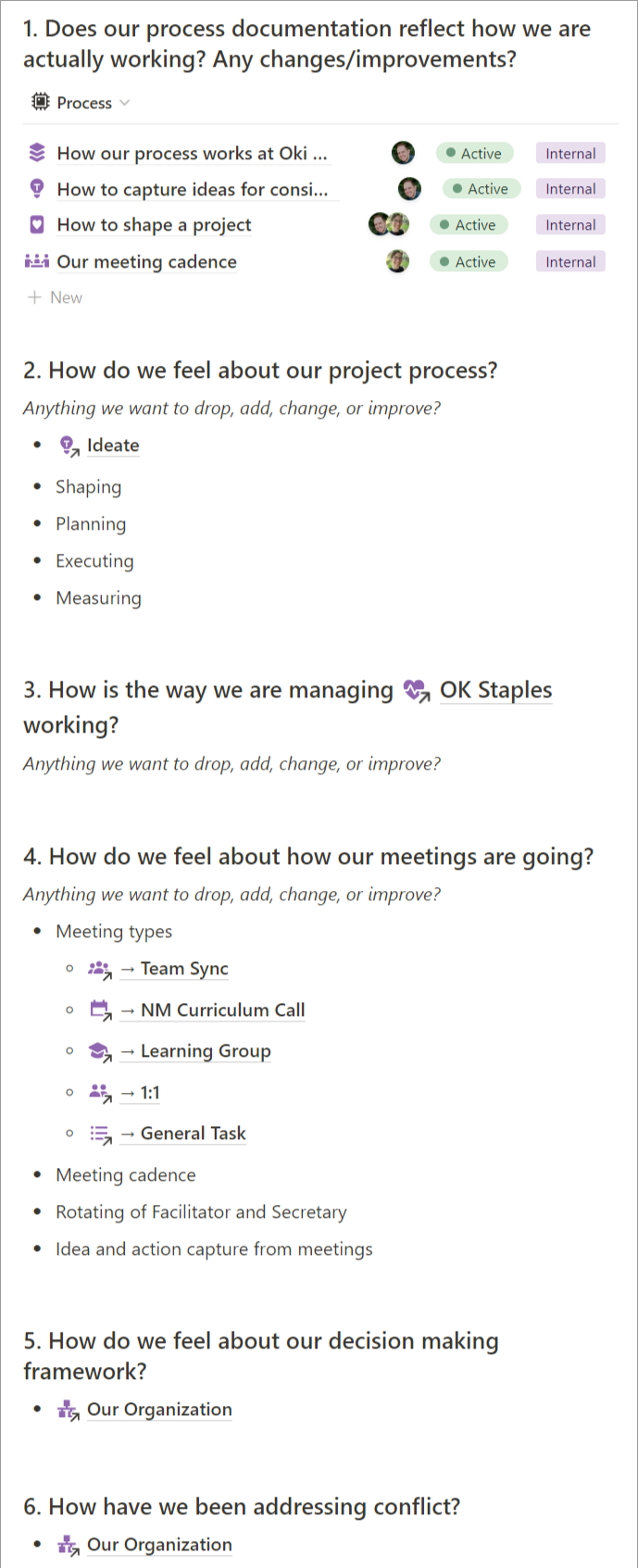
Quarterly Theming: 90-mins
Purpose: discuss our goals for the upcoming quarter, review and align ideas with our goals, and promote aligned ideas to projects for Shaping.
Structure: this is one of our least structured calls. We spend this meeting on our Ideate dashboard which is home to several linked databases that help us make connections between our goals, ideas, and projects. This call is about open, flowing discussion, and an opportunity to get one another on board with the ideas that we want to take action on in the coming months. It’s also a chance to make sure our goals and projects are in alignment and that as team members, we are on the same page in regards to what our focus will be for the next 3 months.
Our ideate dashboard is at the center of our quarterly theming.
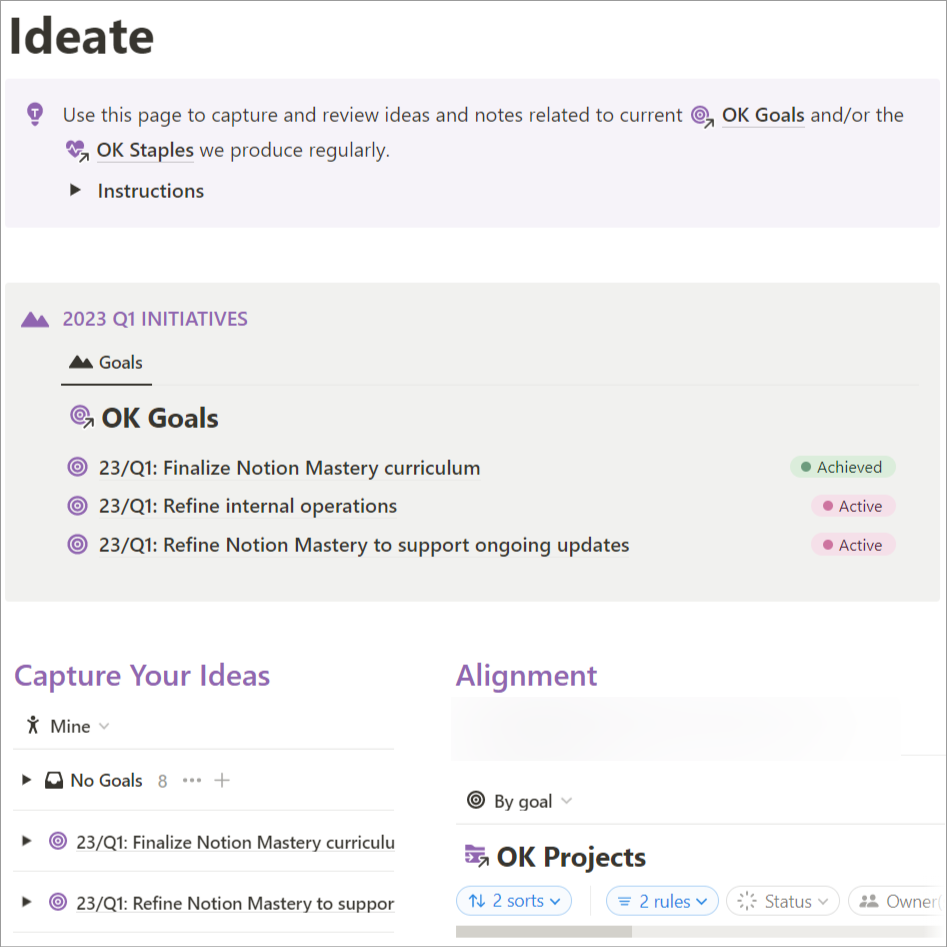
Quarterly Retrospective: 90-mins
Purpose: take time as a team to reflect on the past 3 months and discuss what worked well and what we can improve on.
Structure: I have been tweaking this template over the past few years of running quarterly reviews for our team and this is our most customized template in terms of being specifically designed for our business. It does integrate some linked views of databases, but the template itself also includes a lot of “prompts” to remind me of the analysis I like to do for each area of our business. This is one of the meetings I most enjoy preparing for because the template walks me through the data collection and analysis in a way that’s quite enjoyable and I don’t ever feel like I have to “remember what we want to consider”—it’s all there in the template.
1. Notion Mastery: We start with a general overview of how Notion Mastery is doing, including a review of the number of students who registered, how many new lessons we published, the most popular videos in the course, and a look at an aggregate of our Scorecard data which we collect on a monthly basis.
A snapshot of how we start our quarterly retrospectives.
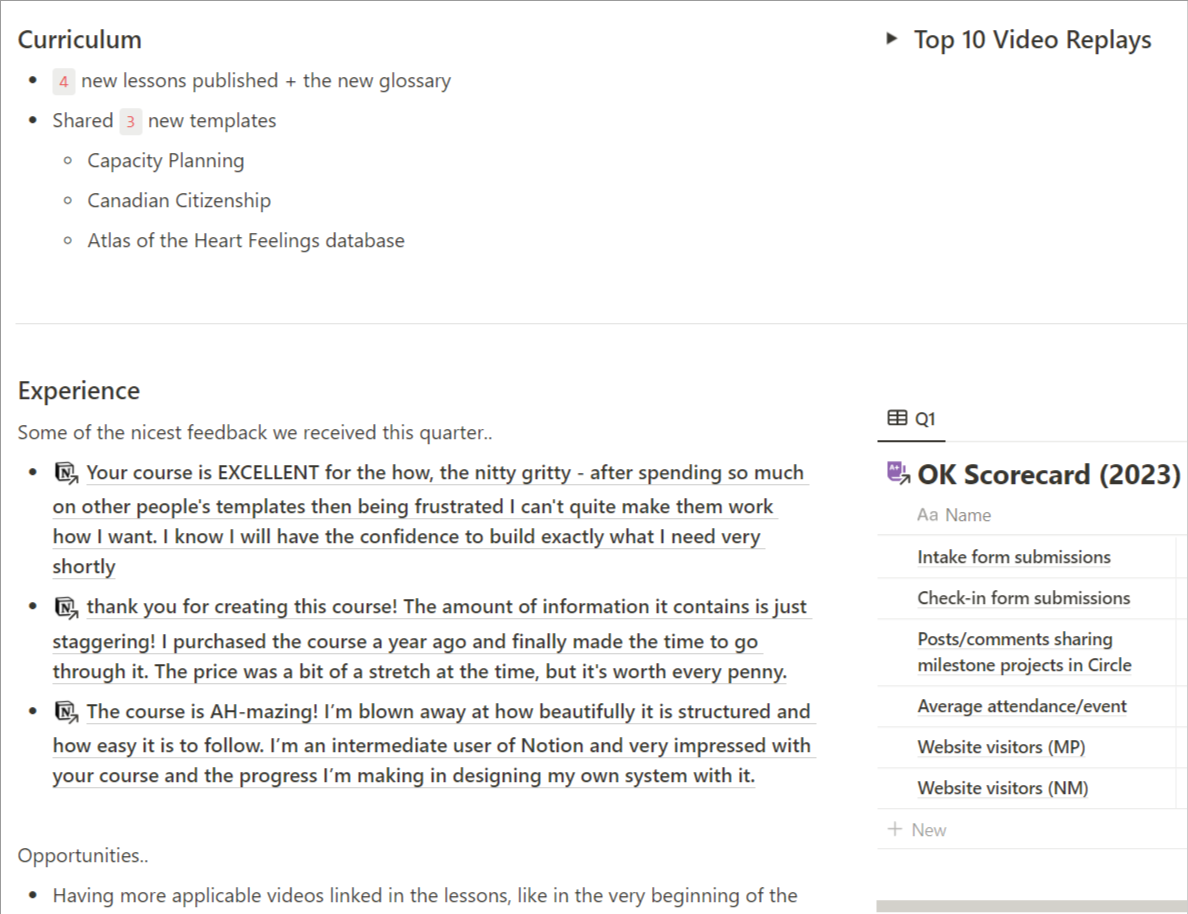
2. Community: We review the overall health of our community, including our events and Circle. For each workshop and demo we ran we look at how many folks registered vs how many attended live, what the average feedback score was, as well as how many times the recording has been played since, to get a sense of what’s resonating with folks. We also look at an aggregate of the Circle metrics we collect each month.
An overview of our quarterly event performance.
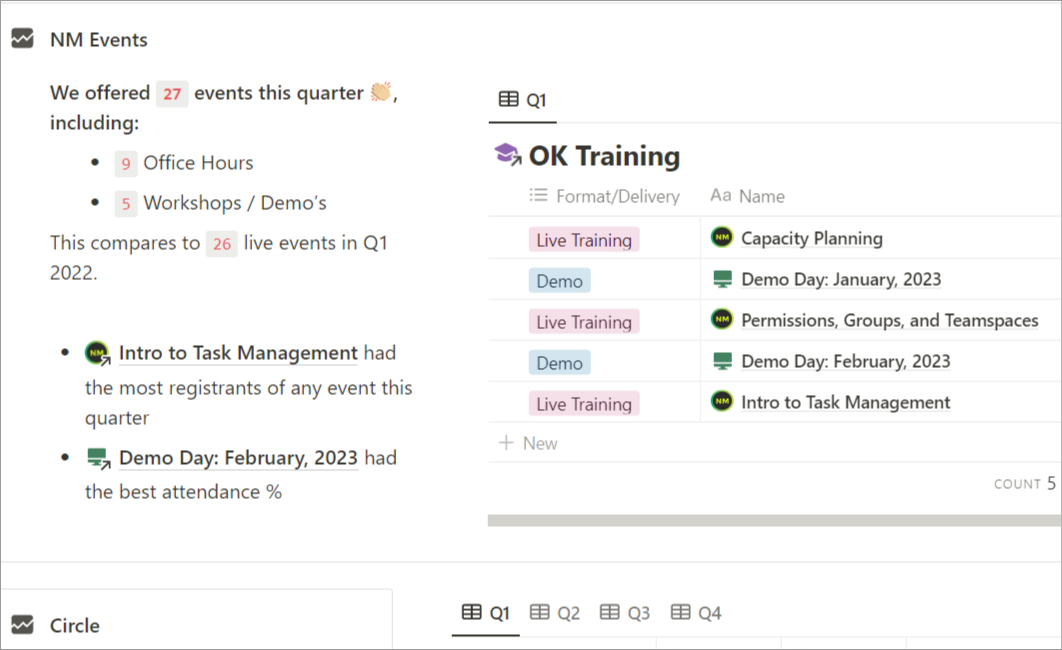
3. Content: We review the performance of the newsletters, blog posts, and YouTube videos that were published in that past quarter. Insights here often inform other content, or even workshops, we want to create going forward.
An overview of how our content is performing.
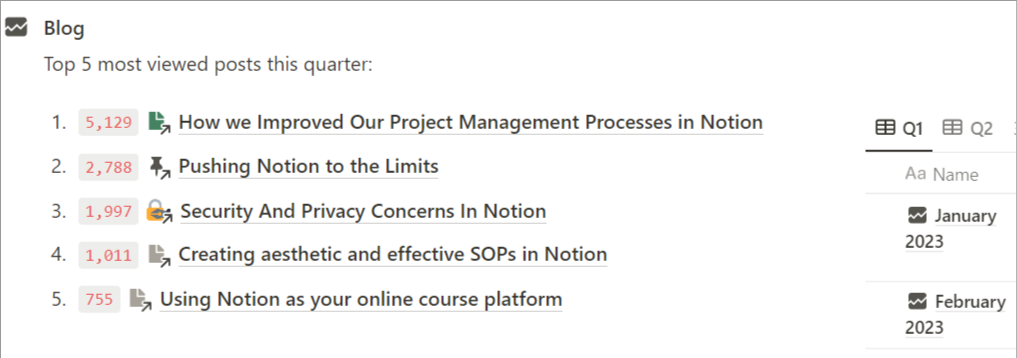
4. Financials: Ben provides us a financial overview and we also review things like stats from our Affiliate program, how many folks are applying for (and using) parity pricing, how many people are purchasing on payment plans, and the performance of our free and paid templates.
Some of the finance-related metrics we review.

5. Projects: A couple linked views of our Projects database are included to show us the projects we completed in the quarter, as well as the work we thought we would do but didn’t start. As a team that has a tendency to overestimate our capacity this acts as a gentle reminder (before we head into the next quarter’s planning session) to be realistic about what’s possible in a 3 month timeframe. This also offers us an opportunity to celebrate the work we did complete!
This is a time to celebrate and a reminder that we can’t do everything.
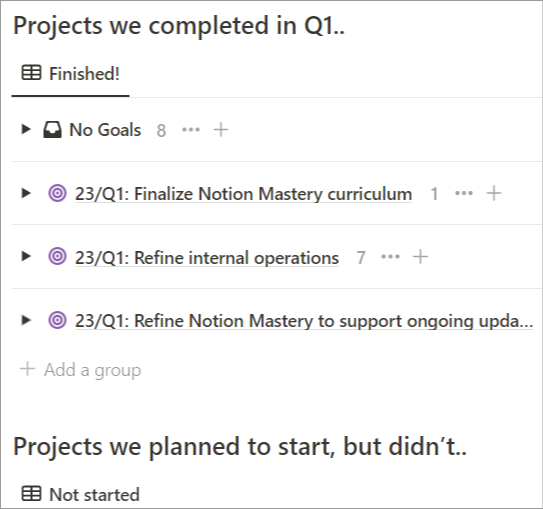
6. Reflections: Our quarterly retro ends with a series of questions that prompt us to reflect on how we felt about the quarter overall, what we’ve been excited about learning and where we want to take that next, and in general what we want from the upcoming three months (and even more importantly: anything we want to let go of, or not bring forward to the next quarter!). We each take turns sharing our responses to these questions. This is one of my favorite parts of this quarterly retro because it is again an opportunity for our team to have deeper and more personal and candid conversations.
These questions always prompt rich discussion.
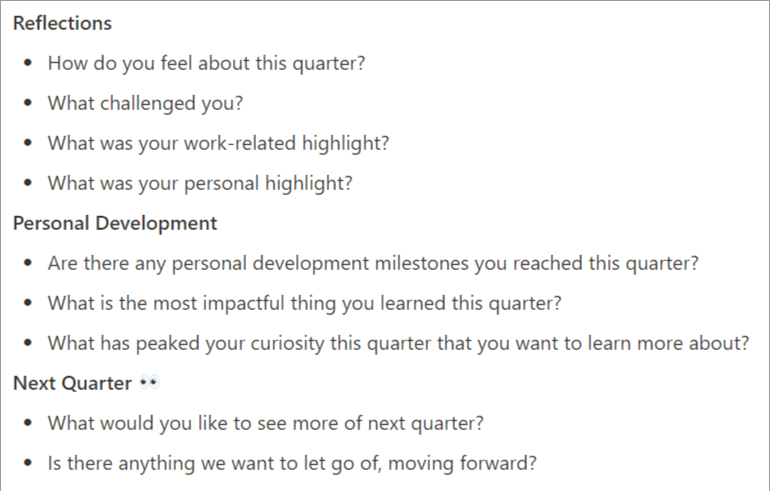
Shaping and Planning
Purpose: to collaboratively shape or plan a new project as well as review the shaping or planning.
Structure: we were predominantly doing our shaping and planning asynchronously, and having our team members review that work asynchronously, but the consensus was we would leverage each other’s skills and knowledge more effectively, and have more fruitful discussions, if we did more of this pre-project work synchronously—so that’s our intention as we move forward! These meetings will be as needed, as we bring new projects online. I talk more about our project management process in this blog post if you want to know more details about how we shape and plan projects.
Holy moly! If you made it this far—thanks for hanging in! That was a deeeep dive into our meeting templates. Hopefully they give you some inspiration for how to use Notion beyond just bullet-point note-taking during a call. Using structured agendas that incorporate linked views of databases can make your synchronous time more effective. Are your meetings missing context? Pull information directly into your template using a linked view of a database so the data is at your finger tips. Action items keep getting missed or lost? Enter them directly into your task database while you’re on the call. Is there a section of your agenda that’s not meeting your needs?
The beauty of Notion is that it’s easy to adjust your templates, adding things in, or taking things away, making meetings more productive and making it easier to get down to work once the call is over.
Increasing our sync time, combined with operationalizing our meeting templates, has improved our collaboration, made our project management more effective, and strengthened the relationships of our remote team.